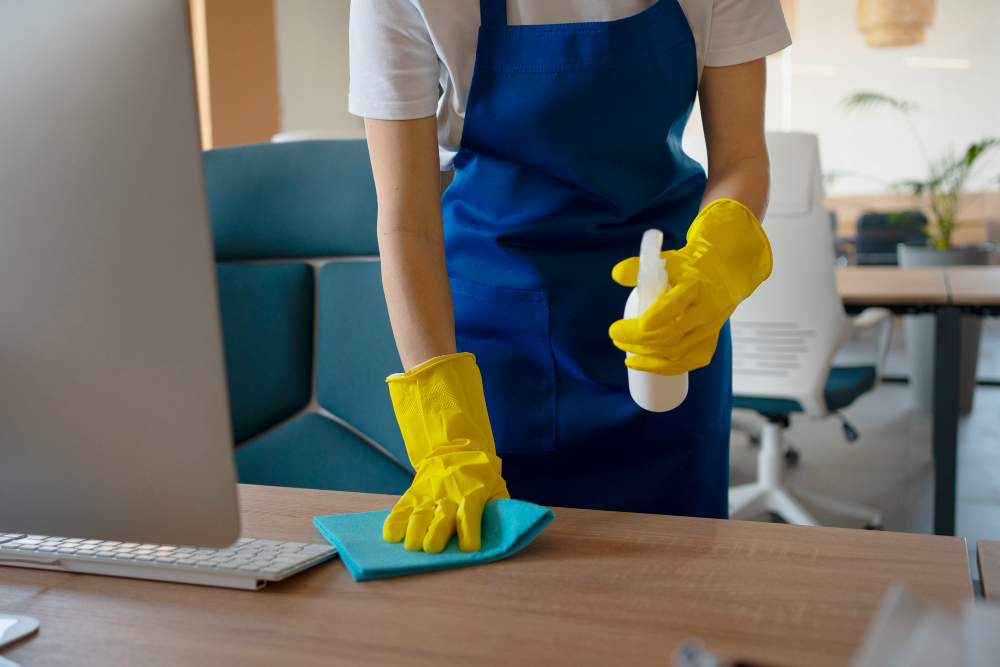
A clean office isn't just about appearances—it's about productivity, health, and creating an environment where your team can thrive. Whether you're managing a small startup or a large corporation, implementing effective cleaning practices can reduce sick days, boost employee morale, and leave a lasting impression on clients and visitors.
The challenge many businesses face is knowing where to start. With so many surfaces, areas, and considerations to manage, office cleaning can feel overwhelming. This guide breaks down the essential best practices that will help you maintain a spotless, healthy workspace while ensuring your cleaning efforts are both efficient and effective.
From daily maintenance routines to deep cleaning schedules, we'll cover everything you need to know to keep your office environment clean, safe, and professional.
Start each cleaning routine by focusing on the surfaces your employees interact with most frequently. Door handles, light switches, keyboards, phones, and shared equipment harbor the most germs and require daily attention.
Use EPA-approved disinfectants and allow proper dwell time—the amount of time a disinfectant needs to remain on a surface to effectively kill germs. Most disinfectants require 30 seconds to several minutes of contact time to be fully effective.
Each workstation should be wiped down daily with appropriate cleaning solutions. Pay special attention to computer screens, which require specific cleaners to avoid damage. Microfiber cloths work best for electronics as they won't scratch sensitive surfaces.
Encourage employees to keep their personal workspaces organized and free of food debris, which can attract pests and create unpleasant odors.
Restrooms require multiple cleaning sessions throughout the day, especially in high-traffic offices. Stock soap dispensers, paper towels, and toilet paper regularly. Clean and disinfect all surfaces including faucets, toilet handles, and door handles.
Floor maintenance is particularly important in restrooms. Mop with a disinfectant solution and ensure proper ventilation to prevent moisture buildup and mold growth.
Different flooring types require specific cleaning approaches. Vacuum carpeted areas thoroughly, paying attention to high-traffic zones that may need extra passes. For hard floors, sweep or dust mop first, then clean with appropriate floor cleaners.
Consider professional carpet cleaning every 6-12 months, depending on foot traffic and usage patterns. Regular professional maintenance extends carpet life and maintains a professional appearance.
Clean windows and glass surfaces weekly to maintain natural light and professional appearance. Use streak-free glass cleaners and clean microfiber cloths. Start from top to bottom to prevent drips from creating streaks on already-cleaned areas.
Don't forget interior glass surfaces like conference room windows and glass office doors, which can accumulate fingerprints and smudges quickly.
Office kitchens require special attention due to food preparation and storage. Clean and sanitize all appliances, including the inside of microwaves and refrigerators. Remove expired items regularly and deep clean coffee makers and water dispensers.
Wipe down all surfaces, including cabinet fronts and backsplashes. Replace sponges and cleaning cloths regularly to prevent bacterial growth.
Clean or replace HVAC filters monthly to maintain air quality and system efficiency. Dust vents and ensure they're not blocked by furniture or equipment. Poor air quality can lead to employee health issues and decreased productivity.
Consider scheduling professional HVAC cleaning annually to remove dust and debris from ductwork.
Dust accumulates on light fixtures and ceiling fans, reducing light output and air circulation efficiency. Use appropriate ladders and safety equipment when cleaning elevated fixtures.
Replace burnt-out bulbs promptly to maintain adequate lighting levels throughout the office.
Monthly cleaning should include storage areas, supply closets, and rarely-used spaces. These areas can accumulate dust and clutter, potentially creating fire hazards or pest problems.
Organize supplies, dispose of unnecessary items, and ensure emergency exits remain clear and accessible.
Clearly define who is responsible for each cleaning task. Whether you have in-house cleaning staff or assign responsibilities to employees, everyone should understand their role in maintaining office cleanliness.
Create written schedules and checklists to ensure consistency and accountability. Regular training helps maintain standards and introduces new team members to proper procedures.
Maintain adequate supplies of cleaning products, paper goods, and equipment. Running out of essential supplies can disrupt cleaning routines and compromise hygiene standards.
Store cleaning chemicals safely and according to manufacturer instructions. Ensure all staff handling cleaning products understand proper safety procedures.
Implement regular inspections to ensure cleaning standards are maintained. Address issues immediately rather than allowing problems to compound.
Consider employee feedback about cleanliness concerns and adjust procedures as needed. Your team can provide valuable insights about problem areas or scheduling conflicts.
Use only EPA-approved cleaning products and follow manufacturer instructions carefully. Provide proper ventilation when using chemical cleaners, and never mix different cleaning products, which can create dangerous chemical reactions.
Store all cleaning supplies in secure areas away from food and out of reach of unauthorized personnel.
Ensure cleaning staff have access to appropriate protective equipment including gloves, eye protection, and masks when necessary. This protects workers and demonstrates your commitment to workplace safety.
Implement proper waste disposal procedures, including separate containers for recycling and hazardous materials. Empty trash containers regularly to prevent odors and pest problems.
Consider the environmental impact of your cleaning practices and choose eco-friendly products when possible.
While many cleaning tasks can be handled in-house, some situations benefit from professional expertise. Large offices, specialized equipment, or demanding schedules may require professional office cleaning services.
Professional cleaners bring specialized equipment, training, and experience that can achieve better results in less time. They also carry insurance and bonding, protecting your business from liability.
Implementing these best practices requires commitment and consistency, but the benefits—improved employee health, enhanced productivity, and a professional appearance—make the effort worthwhile.
Regular cleaning prevents small issues from becoming major problems and creates a workplace environment that supports your business goals. Remember that cleaning is an ongoing process, not a one-time event.
If you need professional office cleaning in Commerce, CA, contact S&W Janitorial Services today to request a quote. Professional cleaning services can help you maintain the highest standards while freeing up your time to focus on running your business.